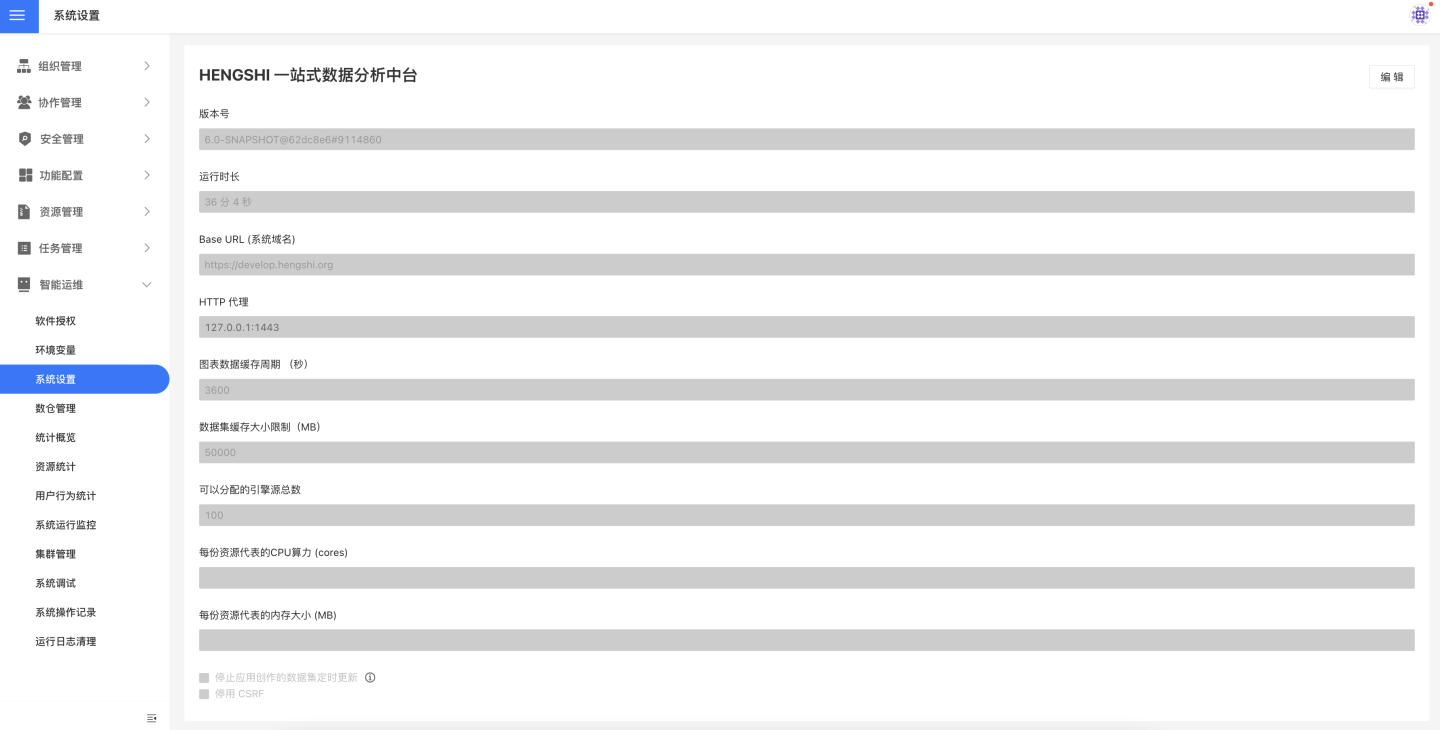System Settings
HENGSHI displays some runtime parameters of the system on the Settings -> Intelligent Operations -> System Settings page, including information related to the main program, Base URL, HTTP proxy, chart data cache period, dataset cache size, tenant engine, and other related information.

Main Program
The system settings display information related to the main program. This information is automatically generated by the system and cannot be modified.
- Version Number: The version of the main program.
- Runtime Duration: The runtime duration of the main program.
Base URL
The root path when accessing this system. It plays an important role in Login Authentication and is the address used when other systems call back to this system.
Example: If you access this system via http://demo.abc.com, then http://demo.abc.com is the Base URL of this system. If it is deployed under a secondary path /analytics and accessed via http://demo.abc.com/analytics, then http://demo.abc.com/analytics is the Base URL of this system.
Chart Data Cache Duration
The chart data cache duration refers to the period during which each query retrieves chart data from the cache. The default is 3600 seconds, i.e., 1 hour. In other words, chart data is stored in the cache for 1 hour, and when the cache duration is exceeded, the system refreshes the data.
This configuration applies to all apps within the system. However, since different apps have varying data update requirements, using a unified configuration may result in some apps updating data too slowly while others update too quickly, making it difficult to accommodate all needs. Therefore, each app can set its own chart data cache duration in the app settings as needed. Once set, the app will no longer be affected by the global configuration.
If you want to obtain real-time data during editing instead of reading from the cache, you can click the Refresh button on the dashboard or chart page. In API calls, you can add the parameter refresh=true to the URL to get the latest data.
Dataset Cache Size Limit
When the acceleration engine is enabled for a dataset, the system will check the size of the dataset. If the dataset size exceeds this configuration limit, the dataset will not support enabling the acceleration engine.
Stop Scheduled Updates for Datasets in App Creation
In the App Creation area, when a dataset enables engine acceleration, entity tables and data are generated in the engine. After publishing, entity tables and data are also generated in the engine. If the App Marketplace also enables an update schedule, the same dataset will have update schedules in both App Creation and App Publishing. This may result in significant pressure on the data source system, and the engine data may double in size, leading to performance degradation. In this case, you can consider stopping scheduled updates for datasets in App Creation, which helps improve the service stability of both the data source and the engine.
Disable CSRF
CSRF (Cross-Site Request Forgery) is a method to prevent web security attacks. When CSRF is enabled in HENGSHI SENSE, users accessing the HENGSHI SENSE API via cookies are required to validate the CSRF token (currently, validation is only enforced for interfaces that cause data changes such as POST/PUT/DELETE; read-only interfaces are not subject to validation).
Tenant Engine
When the tenant engine feature is enabled in the system, the following configurations are required.
Total number of assignable engines: The number of engines that can be allocated. The default is 100, and modification is currently not supported.
CPU power (cores) represented by each resource: The number of cores each resource represents, where "cores" refers to the number of available CPU cores. For example, if the system has a total of 100 CPUs and each resource represents 0.1 CPU power, when a tenant has 1 resource, it means the tenant can use 6 seconds of 1 CPU, while the other 99 CPUs are unavailable. Additionally, the maximum CPU time the tenant can occupy per minute is 60 seconds * 0.1 = 6 seconds.
Memory size (MB) represented by each resource: The amount of memory each resource can use.